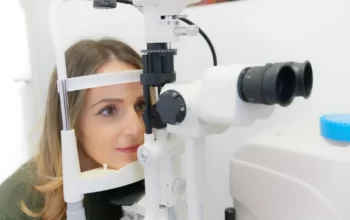
A serious form of sudden glaucoma is narrow-angle glaucoma. Although narrow-angle glaucoma can cause severe symptoms, glaucoma is often called the “sneak thief of sight” because the majority of those who have the condition do not experience any symptoms.
When fluid collects behind the iris, this condition can appear suddenly. A sudden, hazardous rise in intraocular pressure results from this fluid accumulation. Acute angle-closure glaucoma and closed-angle glaucoma are additional names for the condition.
What Is Narrow-Angle Glaucoma (NAG)?
Narrow-angle glaucoma is a type of glaucoma that develops suddenly and can lead to sudden and permanent loss of sight.
Although narrow-angle glaucoma accounts for less than 10% of all glaucoma diagnoses, it can still result in excruciating pain, sudden vision loss, and even blindness.
This condition, also known as “acute angle-closure glaucoma” or “closed-angle glaucoma,” develops when the drainage angle, a part of the eye that allows fluid to normally drain from it, becomes blocked.
The resulting fluid buildup can result in an abrupt, significant increase in intraocular pressure (IOP), which may cause immediate optic nerve damage.
Types Of Narrow-Angle Glaucoma
There are two types of narrow-angle glaucoma: acute and chronic.
Acute NAG
The term “acute NAG” describes when the drainage angle suddenly closes. This type of glaucoma develops when the normal flow of aqueous humor between the iris and lens is abruptly and suddenly interrupted.
Chronic NAG
A narrowed drainage angle is also the cause of chronic NAG, but this type usually doesn’t present with any overt symptoms and develops slowly, causing damage over time.
Causes Of Narrow-Angle Glaucoma
Narrow-angle glaucoma is typically brought on by the iris’s tendency to bow forward, which constricts the area between the clear cornea and the iris, which is where the eye’s drainage angle is situated. The iris is the colored portion of the eye that surrounds the pupil.
Narrow-angle glaucoma has several associated conditions, such as:
- Iris plateau — The ciliary body, which generates the aqueous fluid in the eye and is located behind the iris, is too far forward in the eye in this condition. This pushes the peripheral iris forward, making the drainage angle narrower than usual and more susceptible to obstruction by the peripheral iris’s front surface.
- Hyperopia — High levels of farsightedness increase a person’s risk for angle-closure glaucoma by making it more likely for them to have eyes with shallow anterior chambers and narrow angles (the area in front of the eye between the cornea and iris).
- Tumors and other causes — Angle-closure glaucoma can also be brought on by a tumor behind the iris, swelling brought on by ciliary body inflammation (intermediate uveitis), and changes to the eye’s shape following surgery for a detached retina.
Narrow-Angle Glaucoma Symptoms
Although narrow-angle glaucoma is less common than primary open-angle glaucoma, when it does develop, it can cause much more abrupt and severe increases in eye pressure as well as vision loss. This is especially true if the drainage angle closes abruptly, as it does in the acute angle-closure form of narrow-angle glaucoma.
The warning signs and symptoms of this particularly risky form of narrow-angle glaucoma must therefore be understood.
The following are the warning signs and symptoms of acute angle-closure narrow-angle glaucoma, according to the Glaucoma Research Foundation:
- Sudden severe eye and head pain
- The appearance of rainbow-colored circles around bright lights
- Hazy or blurred vision
- Sudden loss of vision
Unusual pupil dilation, red eyes, nausea, and vomiting are some additional symptoms.
You may experience these symptoms for varying amounts of time. However, each episode of angle closure has the potential to cause a partial loss of your peripheral vision, regardless of how long the symptoms last.
Acute angle-closure glaucoma is regarded as a medical emergency as a result. High eye pressure can result in permanent vision loss if it is not relieved within a few hours. Contact an ophthalmologist right away if you experience any of these symptoms, or head to the emergency room of your local hospital.
Risk Factors Of Narrow-Angle Glaucoma
Regarding narrow-angle glaucoma, the following risk factors exist:
- Farsightedness: A shallow anterior chamber is more typical in people who are farsighted.
- Age: You are more likely to contract the disease as you age because changes to the eye’s anatomy occur.
- Race: Asians and Inuit people have a higher risk of developing narrow-angle glaucoma because they have a shallow anterior chamber and anatomically narrow angles.2
- Sex: Narrow-angle glaucoma is more common in women.
- Cataracts: The lens of the eye can become thicker as a result of cataract growth, which frequently causes the iris to protrude forward and the pupil to become blocked.

Narrow-Angle Glaucoma Treatments
Keeping your eye pressure at a safe, steady level is the best way to treat narrow-angle glaucoma. Here are a few strategies for doing this:
- Eye drops — Some cases of narrow-angle glaucoma may respond well to topical eye drops for the condition.
- Surgery — In order to lower your risk of angle-closure attacks, your eye doctor may recommend glaucoma surgery if narrow-angle glaucoma symptoms are found during an eye exam.
Patients with narrow-angle glaucoma frequently undergo the procedures of iridotomy and iridectomy.
To improve fluid drainage and lessen the chance of angle closure, surgeons perform an iridotomy by using a laser to make a tiny hole in the peripheral iris. A small portion of the iris is removed during an iridectomy in order to improve eye fluid flow.
Having knowledge of the potentially abrupt onset and serious risk associated with narrow-angle glaucoma may make you uneasy, but don’t be concerned. A thorough eye exam can easily identify the condition, and both surgical and nonsurgical treatments are effective in treating it.
First and foremost, prevention begins with knowledge. It’s time to schedule an appointment with your eye doctor if you are classified as “at-risk” and it has been a while since your last eye exam. You at least acquire mental tranquility. You at most keep your vision.
A serious form of sudden glaucoma is narrow-angle glaucoma. Although narrow-angle glaucoma can cause severe symptoms, glaucoma is often called the “sneak thief of sight” because the majority of those who have the condition do not experience any symptoms.
When fluid collects behind the iris, this condition can appear suddenly. This accumulation of fluid results in an abrupt, hazardous rise in intraocular pressure. Acute angle-closure glaucoma and closed-angle glaucoma are additional names for the condition.
Narrow-Angle Glaucoma Prevention
People who could be at risk for developing narrow-angle glaucoma can be located. Even if you aren’t displaying any symptoms, doctors can still perform a peripheral iridotomy (PI) as explained above.
By doing so, the iridotomy will give the fluid a chance to escape if the angle does indeed close, preventing dangerously high-pressure levels. Each year, a person with an iridotomy should be examined to make sure the iridotomy is still open and has not closed.
Conclusion
When you are informed of the rapid onset and severe effects of narrow-angle glaucoma, it is simple to start feeling worried.
Thankfully, the condition can be identified by a thorough eye exam, and there are a number of effective treatments available to address it. The likelihood of vision loss is decreased the faster any form of glaucoma is identified and treated.



